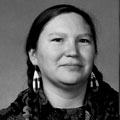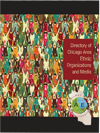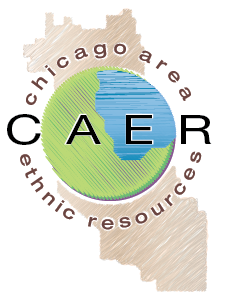-
My Grandmother's Grandmother
By Rosalyn LaPier

My Blackfeet name is K-tia-i-tse-kus, or Not Real Beaver Women. It is the name of my grandmotherʼs grandmother. I come from two very large families. My mother is Blackfeet, from Montana and Alberta, Canada. My father is Chippewa, from North Dakota/Manitoba. His family moved to Montana 150 years ago. On both sides, I have relatives in both Canada and the U.S.
The homelands of many tribes were unalterably changed with the creation of the Canadian/U.S. border we call the “49th parallel.” At first, many tribes refused to admit its existence and continued with life as normal, which they were able to do because there were few white settlements and little enforcement at the border. But with the increased use of police against Native peoples, we eventually stayed on our respective sides. The process was heartwrenching.
At one point in the history of my fatherʼs family, the U.S. government declared them all Canadian citizens, rounded them up and under Army guard walked them to the Canadian border. But Canada refused them entrance, so they were forced to walk the hundreds of miles back to their homes.
As the years passed other ethnic groups have married into my family, including Irish, Spanish and French. All these people quickly integrated themselves into the family, and we have remained fundamentally Native. Both my Native families joke that any nefarious activity was brought on by their “white” blood.
Native Americans are unique in that America came to us — we did not come to America. Native Americans experienced reverse immigration. A new country surrounded and consumed our homelands. The borders of the present-day Blackfeet reservation in Montana were created only 100 years ago.
My grandmotherʼs grandmother, for whom I am named, was a mother raising children at that time. She was trying to survive in a world she could hardly recognize. The old people around her remembered times of rapid change and deprivation. They told about those times to their grandchildren, who in turn are telling it to their grandchildren.
My grandmotherʼs grandmother lived through the “Starvation Winter,” when the Blackfeet were not allowed to leave the reservation to look for food and one-third of all tribal members starved to death, while many more suffered from disease.
All the while, new immigrants from far-away lands, moved to Montana and got homesteads on land that once belonged to my grandmotherʼs grandmother and her fellow Blackfeet. This disastrous time, as much as anything, shapes the present-day fabric of our home community. With the loss of land, a dramatic change in societal structure and the death of many family members, the Blackfeet were forced to reconstruct themselves within reservation boundaries. This reconstruction is at the root of present-day problems.
Many of the changes in the life of my families were brought by outside forces. The Blackfeet, who always had held land in common, were forced to take individual lots of land in 1907. We did not want to become Americans, but all Native Americans were made citizens by an Act of Congress in 1924. The U.S. government has done everything in its power to force Native Americans to assimilate into American society. They outlawed our religions (until 1978). They forced previous generations to stop speaking Native languages in school and to wear “civilized clothes.” They tried to change the societal and family structure and the gender roles of most tribes, making men take on womenʼs work, such as raising crops, and forcing women out of their traditional role as spiritual and ritual intermediaries.
Fortunately, Native Americans have successfully fought every attempt at assimilation the government has tried and have maintained a heritage firmly based in our own values, which say the community and family come before the individual, and that there should be generosity and sharing of wealth. With this history of resistance, it is ludicrous for some to suggest Native Americans ever wanted integration. Most people assume we want what other minority groups in the U.S. want, but we want to maintain our separate societies.
I often am asked, “What do you people want from us?” There is a simple answer. We want the U.S. government to uphold the treaties they signed with us. Americans believe they have inalienable rights, as expressed in the Constitution. Native American rights stem from tribal systems that have existed for centuries, and also from their treaty rights, guaranteed by the Constitution.
This fundamental difference in how Native Americans view their legal rights in this country is something most people miss. We do not view ourselves as a minority group, but rather as distinct political entities within the United States.
Many of us have moved to cities like Chicago for a variety of reasons, some short-term others permanently. I came for educational and economic opportunity. Many Native people like myself view their residence outside their homeland as temporary, although it may last decades. Even fourth-generation residents here have a strong sense of their tribeʼs history.
Others may think Native Americans live in “two worlds” but I have never felt this dichotomy. I feel rooted in the Native community wherever I am. It is my husband, more than myself, who must live in two worlds. He was raised in the North Shore suburbs of Wilmette and Evanston and comes from a middle-class family of German and Swedish heritage. He has had to re-think his American-defined values and concepts to integrate himself into Native society, which he has done successfully.
Though I live in Chicago, Montana is still my home. I probably will retire there. When I see the mountains, prairies and river valleys, I am reminded of the long history of my people and can feel the spirit of my ancestors around me. Most of my family still lives there and will for generations to come. I may spend only one or two months a year there, but I think of my home and family every day.
My children need to know their grandmothers, aunts, uncles and cousins, so that they too can know what it is to be Native American. They also need to have that special relationship with the landscape that has shaped the values, language, religion, arts and culture of their ancestors. My children need to remember the things their grandmother tells them, and pass them on to their own grandchildren.
Rosalyn LaPier is an independent researcher for Native American organizations, an instructor at NAES College and
a full-time mother of two.Return to Links & Features
Available Now!
The
Chicago Area Ethnic
HandbookEasy-to-use chapters on the histories and traditions of
37 ethnic groups.
Second Edition
UPDATED and EXPANDED!

The Directory
of Chicago Area Ethnic Organizations
and Media Who they are, what they do and how to reach them.
Third Edition



